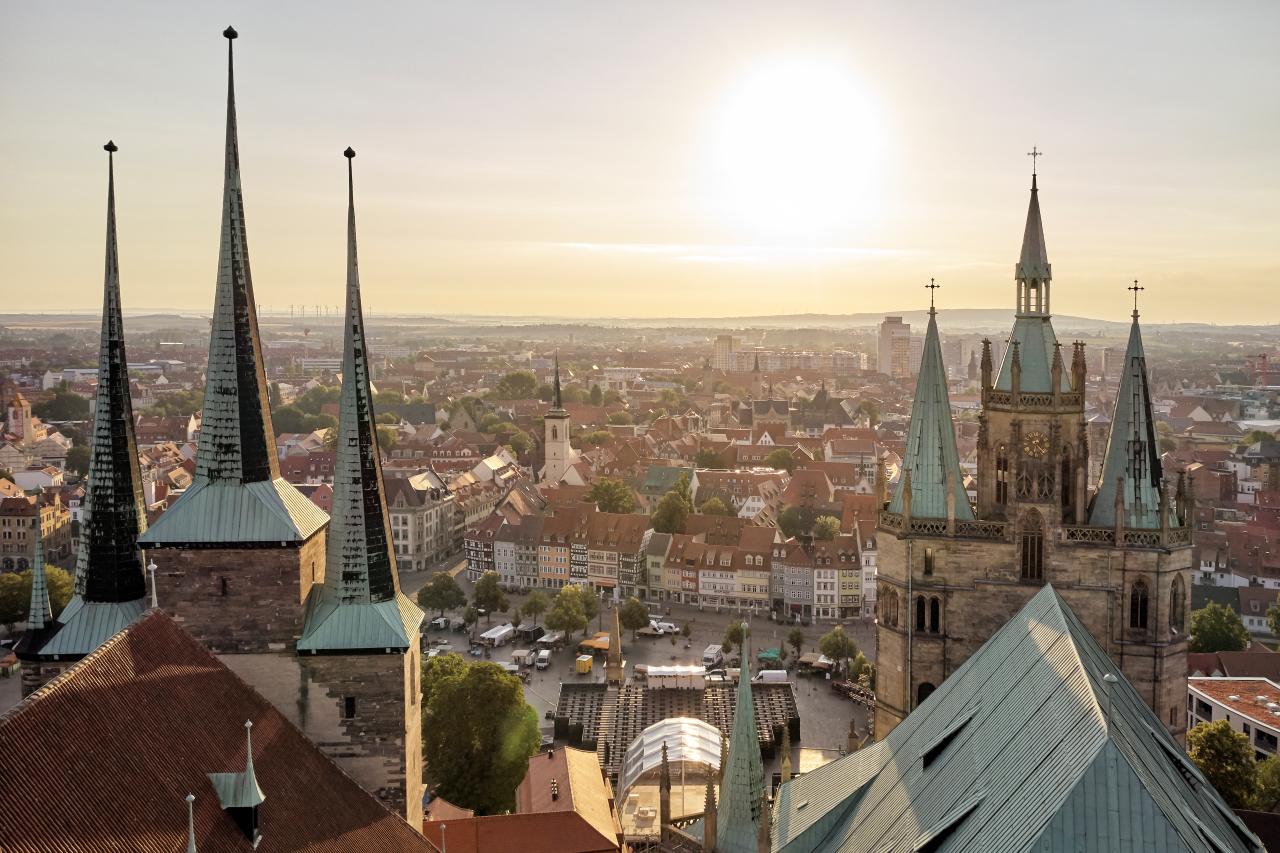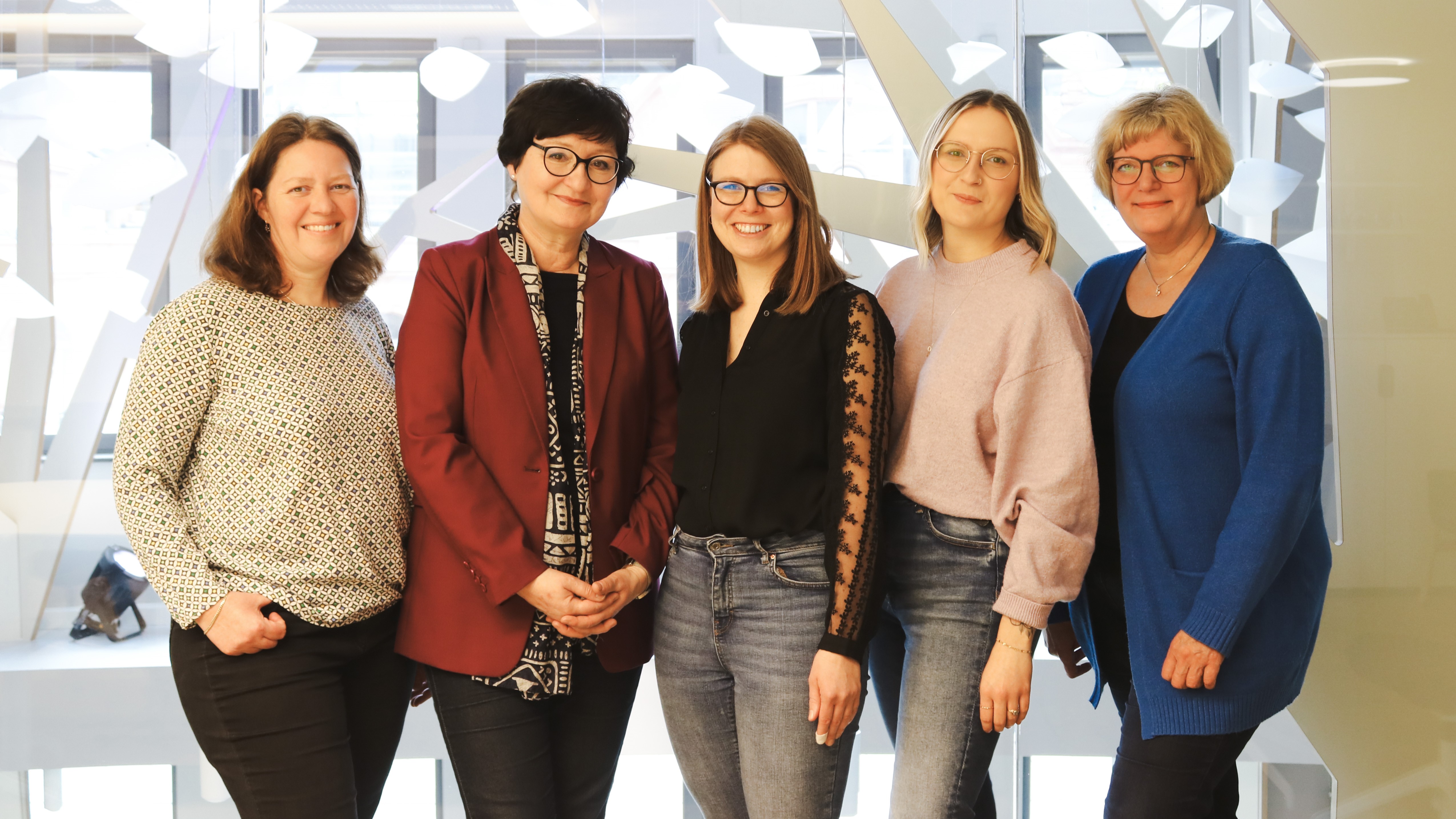Finden Sie Ihre Ansprechpartnerinnen für alles, was mit Thüringer Auslandsmarketing und B2B-Themen zu tun hat. Hier!
Bauernkriegsmuseum Kornmarktkirche
Das bewegte Leben einer Kirche
Im Jahre 1525 kam der Kornmarktkirche eine Bedeutung zu, die mit ihrer eigentlichen Bestimmung nichts zu tun hatte – sie wurde von den Bauern, Handwerkern und Bürgern der Region als Versammlungsstätte vor der Schlacht in Bad Frankenhausen gegen die Soldaten der fürstlichen Obrigkeiten genutzt. Es heißt, dass in dem Gebäude Kirchenglocken eingeschmolzen wurden, um Kanonen zu gießen. Der Aufstand ging dramatisch und vernichtend für die Bauernschaft und ihre Anhänger aus. Gäbe es daher einen sinnigeren Ort für das Bauernkriegsmuseum als einen der Originalschauplätze?
Schlichter Stil, mächtiger Idealismus
Ursprünglich wurde die Kornmarktkirche in der ersten Hälfte des 13. Jahrhunderts als Bestandteil des Klosters der Franziskaner errichtet, die sich damals dort niederließen. In Anlehnung an ihre Ordensphilosophie galten für den Bau strenge Vorgaben in puncto Schlichtheit. Nach der Reformation wurde das Kloster abgerissen. Nur noch die mittlerweile profan genutzte Kirche, der kleine Klostergarten sowie das Lapidarium erinnern an diese Epoche – und die Barfüßerstraße, die zum Bauwerk führt, die Mönche dieses Ordens trugen in der Regel keine Schuhe …
Sieh in mir den Regenbogen
Nach der Säkularisierung Anfang des 19. Jahrhunderts wurde das Bauwerk über eine Zeitspanne von 170 Jahren stark beansprucht – zunächst als Stätte der städtischen Waage und als Kornlager; später wurde das Innenleben architektonisch völlig umgebildet, um Wohnungen und Büros einzubauen. In den 1970er Jahren bekam die Kornmarktkirche nach aufwändigen Renovierungen eine neue Bestimmung als Tagungs-, Konzert- und Ausstellungsstätte – was sie vor dem Abriss bewahrte. Die Umsetzung des Projekts verlangte ein gewaltiges Stück Arbeit sowie reichlich Budget. Seit der Grundsanierung strahlt über dem Bereich, wo üblicherweise der Altar platziert ist, ein künstlerisch gestaltetes Fensterelement, das beim genauen Hinsehen einen bunten Regenbogen zeigt. Der radikale Reformator Thomas Müntzer, der in der Mühlhäuser Marienkirche als Prediger wirkte, wählte dieses „Himmelszeichen“ als Sinnbild für die Verbindung zwischen Gott und den Menschen – später wurde es in diesem Kontext zum Symbol des Bauernkriegs.
Bauernkriegsmuseum – Besuch mit Tiefenwirkung
Das Kirchenfenster bildet eine stimmige Kulisse für die Dauerausstellung „Luthers ungeliebte Brüder“. Die museale Aufarbeitung des Bauernkriegs von 1525 beginnt mit den Ursachen des Aufstands, geht über verstärkende Faktoren wie die populäre mediale Welt zu Beginn der frühen Neuzeit mit ihren Flugschriften und reicht bis zur großen, von den Bauern verlorenen Schlacht in Bad Frankenhausen samt den schwerwiegenden Folgen. Ein Großdiorama zeigt, wie das Kampffeld ausgesehen haben könnte, und löst zugleich ein beklemmendes Gefühl aus – nur circa ein Viertel der Aufständischen überlebte und Thomas Müntzer wurde hingerichtet. Verschiedenste Exponate wie eine nachgebaute Druckerpresse, Bücher, Büsten, Kupferstiche, Waffen und von Bilderstürmern zerstörte christliche Artefakte machen den Großteil der Ausstellung aus. Außerdem verdeutlichen bildliche Darstellungen das ganze Ausmaß der Geschehnisse. Informative Texte sowie eine interaktive Filmstation zu Klostergärten und Gartenkultur der Franziskaner vermitteln Grundlagenwissen oder erweitern es.
Nachhaltige Historie
Die Bauernaufstände von 1524 bis 1526 in einigen Ländern brachten insgesamt erstmalig die gesellschaftliche Rangordnung und die damit verbundene Zuteilung von Rechten und Privilegien gewaltig ins Wanken. Die Aufständischen wurden zwar streng bestraft, gleichzeitig aber entwickelte sich aus der Angst vor weiteren revolutionären Bestrebungen ein neues Bewusstsein bei den Herrschenden – mit unterschiedlichen Auswirkungen. Ein Besuch bewirkt sicherlich nachgehende Überlegungen und Gespräche, denn das Leben heute ist in vielerlei Hinsicht eng mit dieser Thematik verstrickt.
Um den Mühlhäuser Kornmarkt herum
Die Gedankenwelt lässt sich mit einem Besuch des Wirtshauses „Brauhaus Zum Löwen“, das der Kornmarktkirche gegenüberliegt, gut wieder auflockern. Das Gebäude sieht auf eine über 300 Jahre lange Geschichte zurück. Die Brauerei bietet eine Reihe von eigenen Bieren – es wird Ihnen schmecken. Der Blick vom Biergarten auf dem Kornmarkt direkt auf die Kirche ist wunderbar.
In der Landesausstellung werden die aufeinander aufbauenden Phasen des Bauernkriegs aus überregionaler Perspektive gezeigt. Das Bauernkriegsmuseum Kornmarktkirche ist Teil der Thüringer Landesausstellung 2025 – und eine der vier prägnanten Stationen in der mittelalterlichen Reichsstadt Mühlhausen. In diesem Museum, der zweiten Station, erfahrt ihr Spannendes und Überraschendes über die damaligen Ereignisse – Entstehung, Eskalation und Konsequenzen – sowie über bekannte Akteure, aber auch historisch weniger beachtete Schlüsselfiguren.
Unter der Überschrift „freiheyt 1525. 500 Jahre Bauernkrieg“ gedenkt Thüringen 2025 der Ereignisse des Deutschen Bauernkrieges in Thüringen von 1525. Zentrum der Ausstellung ist die historische Stadt Mühlhausen mit ihren Museen und Müntzer-Gedenkstätten. Ergänzt wird dies durch Ausstellungen im Panorama Museum Bad Frankenhausen, das direkt auf dem alten „Schlachtenberg“ steht. Informationen gibt es bereits jetzt unter bauernkrieg2025.de und in unserem B2B-Portal.
Titelbild: ©Tino Sieland, Wirtschaftsbetriebe Mühlhausen GmbH/ Geschäftsführer Martin Fromm
Grafik im Website-Block: Sebastian Köpcke, Mühlhäuser Museen
Gästeinformation
Bad-Ausstattung
Museum-Information
Architektur-Information
Unter Tage
Anwendungen und Heilanzeigen
Mobilitätsangebote
Sauna-Ausstattung
Ensemble
Angebote und Service
Größe
Tagungsausstattung
Entfernungen
Verkehr









